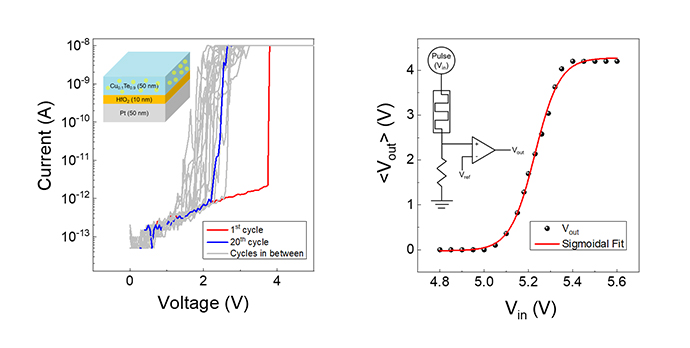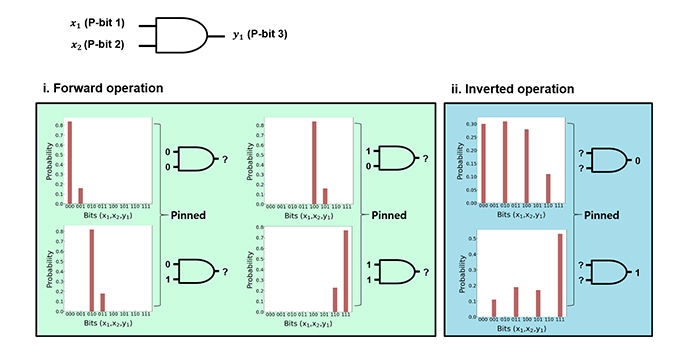 HOME > Research > P-bit Computing
HOME > Research > P-bit Computing
P-bit Computing
P-bit Computing
1. True Random Number Generator
- As the global market for the Internet of Things (IoT) is growing by huge amounts, data privacy has become the subject of intensive research. A true random number generator (TRNG) is hardware security that generates random bits from its intrinsically stochastic physical process. Recently, the memristor's nonuniformity, mainly due to the stochastic physical phenomena during the switching, has been employed as random sources for cryptographic applications, such as TRNGs and physically unclonable functions (PUFs). Since the volatile memristor does not require a RESET process, the research focus has shifted toward volatile-memristor-based TRNGs. A scalable and reliable way of realizing the TRNG using a Pt/HfO2/TiN electronic-switching-based memristor was proposed. The memristor with the electronic switching mechanism is preferable due to its low power consumption and excellent reliability. The novel TRNG circuit design exhibits several advantages, such as simplicity, scalability, and longevity. Another new type of TRNG using the stochastic threshold switching of a Cu0.1Te0.9/HfO2/Pt diffusive memristor was created. It was combined with a nonlinear feedback shift register (NFSR), which enhanced the bit generation rate with minimal power consumption. The memristor-based TRNG experimentally proved the feasibility of adopting the memristor in security applications for the IoT era. Furthermore, the capability of generating random bits can be applied to probabilistic computing explained in the next section.


2. Probabilistic computing
- Due to the explosive growth of big data, the need for new computing hardware that can handle complex tasks, which cannot be easily executed with the classical computing based on the von Neumann architecture, is growing. Quantum computer shows the potential to exceed the performance of the classical computer, but maintaining cryogenic operation temperature leads to enormous energy consumption. Recently, a new method of probabilistic computing (p-computing) that can complement the problems of the aforementioned computing methods has been introduced. The probabilistic bit (p-bit), which gives '0' and '1' continuously changing over time, has both the probability of being '0' and '1', and these probabilities can be changed by an input variable. This work suggests a new computing scheme of p-computing using a threshold switching diffusive memristor. The Boolean functions were implemented by designing a p-computing system based on memristor-based p-bits. The memristor-based p-computing can perform both forward and invertible operations, showing the possibility of expanding its uses for complex problems, such as integer factorization.



Related Papers :
- K. S. Woo et al. "A True Random Number Generator Using Threshold-Switching-Based Memristors in an Efficient Circuit Design." Adv. Electron. Mater. 5, 1800543 (2019).
- K. S. Woo et al. "A Combination of a Volatile-Memristor-Based True Random-Number Generator and a Nonlinear-Feedback Shift Register for High-Speed Encryption." Adv. Electron. Mater. 6, 1901117 (2020).
- Z. Wang et al. "Resistive switching materials for information processing." Nat. Rev. Mater. 5, 173-195 (2020).
- K. S. Woo, J. H. Kim et al. "A High-Speed True Random Number Generator Based on a CuxTe1-x Diffusive Memristor." Adv. Intell. Syst. 3, 2100062 (2021).
